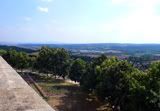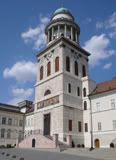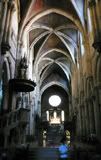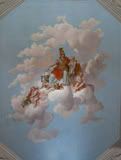|
Day 7
Wednesday June 20 - Day 10 Saturday June 23
We left Eger just after breakfast around 9 AM. As I mentioned
above, we had had a very early wake-up with that very loud couple
whining about their car at 5:30 AM. Once again we decided to take
a slight detour rather than just a M3 scream. We headed west from
Eger aiming towards a ruined castle that I found in my Rough
Guide. It is just outside Sirok which was only 20 km away.
The road to get there wound up & down through the big hills of the
Mátra range. Very beautiful country. From the town of Sirok,
we followed the Var (castle) signs to a parking area. We could see
the castle on the hill above us. The 20 minute climb up was easy,
on a paved pedestrian-only road with the last bit on cobbled
stones. Once again, the heat was rising, so I'm glad we were doing
this in the morning.
Wow. A view for miles in every direction. And the ruins
would warm any romantics heart. A 13th Century castle that has
been in ruins since the Turkish occupation. On a crag of rock with
a view for miles. There are some carved passages with ladders to
get to the remaining heights so you could poke around. I loved it.
And there were only 2 or 3 other people wandering around so it isn't on
the tourist path. There are no services except in the town
below.
|
|
We then meandered down to
the M3, gassing up the beast (with 'benzene' as they called normal gas -
95 Grade - 294.50 Ft per litre) & buying a toll pass (under $10.00
CDN) at the same time. From there, it was an easy run into Budapest. Our goal was to
go straight through Budapest. On surface roads of course, since as
I mentioned before, there aren't any highways that loop around or
through. Well, goals aren't always attained that easily. I
missed one crucial ramp heading left that I saw as we zipped by &
then we were dumped into traffic heading towards the Margit Hid - rather
than the Erzébet Hid which had been my preference. We crossed into Buda
& then just followed the cars in front of us who seemed
purposeful. Maybe purposeful but certainly not going where we
were. We were map challenged for this part of town & we kept
driving & driving until we realized that we were lost. No
streets were on our map & no signs were visible for the M1 which is
the highway west.
Time for help. A stop at a gas station revealed that we were way
out of our way. Thankfully we got great directions & with only
3 or 4 street combinations we found our way from outer Pest, into a
forest, through Budkeszi, past hookers in bathing suits standing in
remote driveways to our destination: an M1 onramp. Whew.
Once on the M1, it was smooth sailing. The hills around Buda
continued west until Tata which made the drive quite scenic. But
it was just like driving in any country on any highway. Like elsewhere
in Europe, people drive reasonably fast. My 130 km/hr was average
on the M-Series. But slower is OK too, just expect to be passed by
everybody.
As we approached the first of the Győr interchanges, we could see a
line of big hills (Sokor) to the south including the one with the
Pannonhalma Monastery - very visible 20 kms away. We exited off
the M3 & found our way to Győr - Ménfőcsanak, our
destination. This is a southern rural suburb of Győr.
For this part of the narrative &
for the next couple of day's descriptions, I will take a different
approach & I won't have a blow by blow. This was family
time. We ate family meals & not in restaurants. We
stayed for 2 nights with Babi (bub-by) & her husband Béla (bay-la).
Babi is a cousin on my wife's mother's side & they went with us to
visit that side of the family with some site seeing thrown in.
Then for another night, we stayed with Feri & Erika (our Budapest
guides) in their flat right in Győr & rushed around visited my
wife's father's side. With a little sight seeing also. But I
have never, nor would I have ever thought it possible, kissed so many
men's, women's & children's cheeks in such a short period of time.
Here's the deal.
Hungarian style. You call ahead that you will be visiting.
When you arrive, you go through a round of kissing & handshakes
& hugs. Then you are ushered into the kitchen or sometimes the
living room. You sit. The host instantly brings out a silver
platter with drinks & glasses. Since we were heat wave summer
time, it was always a cold or cool fruit drink and/or pop &
water. Always. And then they ask if anyone wants coffee (kav-vey)
or wine (bor). I'm sure that pre-0 Tolerance days, the wine &
shots of fiery Pálinka flowed often. Kind of like we used to do
the same with beer. And of course, food arrives instantly
too. Most often just pretzels & similar munchies but sometimes
cakes or strudel etc. That is considered the minimum in Hungarian
hospitality. For any guest. When you leave, you repeat the
round of kissing & handshakes & hugs. With
everybody. This was family.
Since I usually sat there in a stupor, I smiled & nodded & hand
signed (charades style) with everyone. I started to get used to: yes =
e-gan
. no =
nem
, good =
yol
, thank-you =
kis-eh-nem
, thank you were more enthusiasm =
kis-eh-nem sea-pen
. Those are the basics in English-speak. And of course, cheers =
aggie-sheg-a-dra
- the subtitle of this literay mess. These are close enough to the
pronunciation to be understood. Oh & while I'm at it, castle = var =
var
, downtown area = belvaros =
bel-var-rowsh
. You might also note that I added the double accents to the O in Győr.
And it's dyur (not di-er). Sorry about that
earlier faux pas. It gets confusing.
So, for this part of my narrative, I will highlight the sites we saw
that were of touristing interest & throw in some random pictures
& observations of normal Hungarian life.
|




